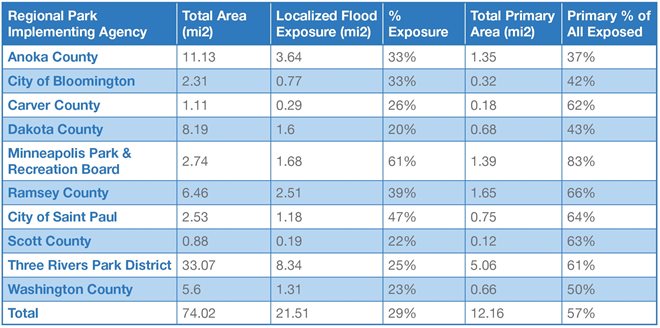The seven-county Twin Cities metropolitan region is home to a system of regional parks and trails that are nationally renowned for their beauty, size, and variety of features. This system, known as the Regional Parks System, was established in 1974 to provide regional recreation open space for public use. Today, the Regional Parks System consists of 54 regional parks and park reserves, 43 regional trails totaling nearly 400 miles, and eight special recreation features, with an estimated 58.3 million visits in 2017.
To better understand the methods and Council approach employed in creating the localized flooding data layer, please refer to the document entitled
Localized Flood Risk Introduction.
The table below provides information on overall localized flooding potential for each regional park implementing agency, with surface water area removed. The Minneapolis Park and Recreation Board carries the highest percentage of exposure with 61% of the park areas within a potential Flood Impact Zone, followed by the City of St. Paul, with 47% exposure. The Regional Park Implementing Agency with the lowest potential exposure to localized flooding is Dakota County, with 20% exposure.
There is variation among agencies in the percentage of park land within the Primary Flood Impact Zone (FIZ). The Primary FIZ are the first areas to fill with localized flood water and therefore tend to carry the highest risk.
Table - Regional Parks Potential Localized Flood Vulnerability by Implementing Agency

It is important to note that the Table shows systemwide percentages and averages. Asset-based and site-specific analysis (assessment of a certain park or trail, for example) can be conducted to clearly identify and prioritize areas of vulnerability and subsequent site-specific strategies to increase resilience of park assets.
The full
Regional Parks Chapter describes and maps the vulnerability of different components of the regional parks and trails system, including the methodology for assessing vulnerability by asset, analysis, considerations for planning and response, and strategies for addressing the system vulnerabilities.